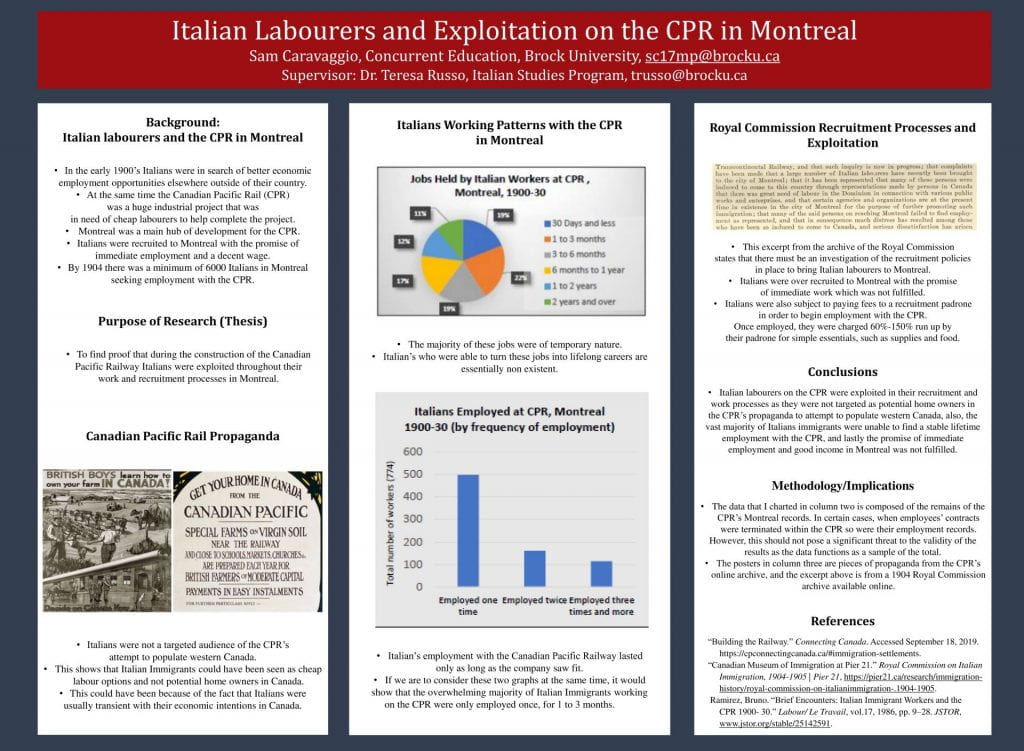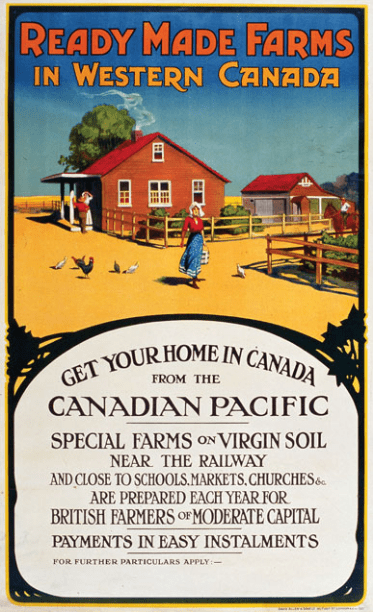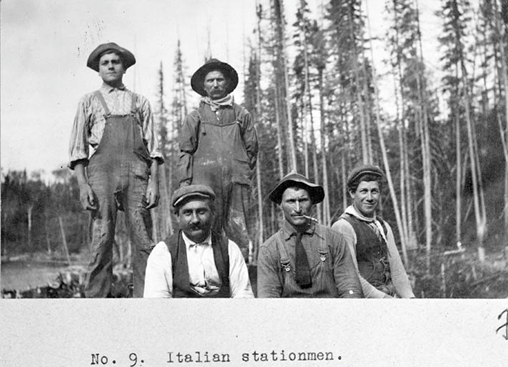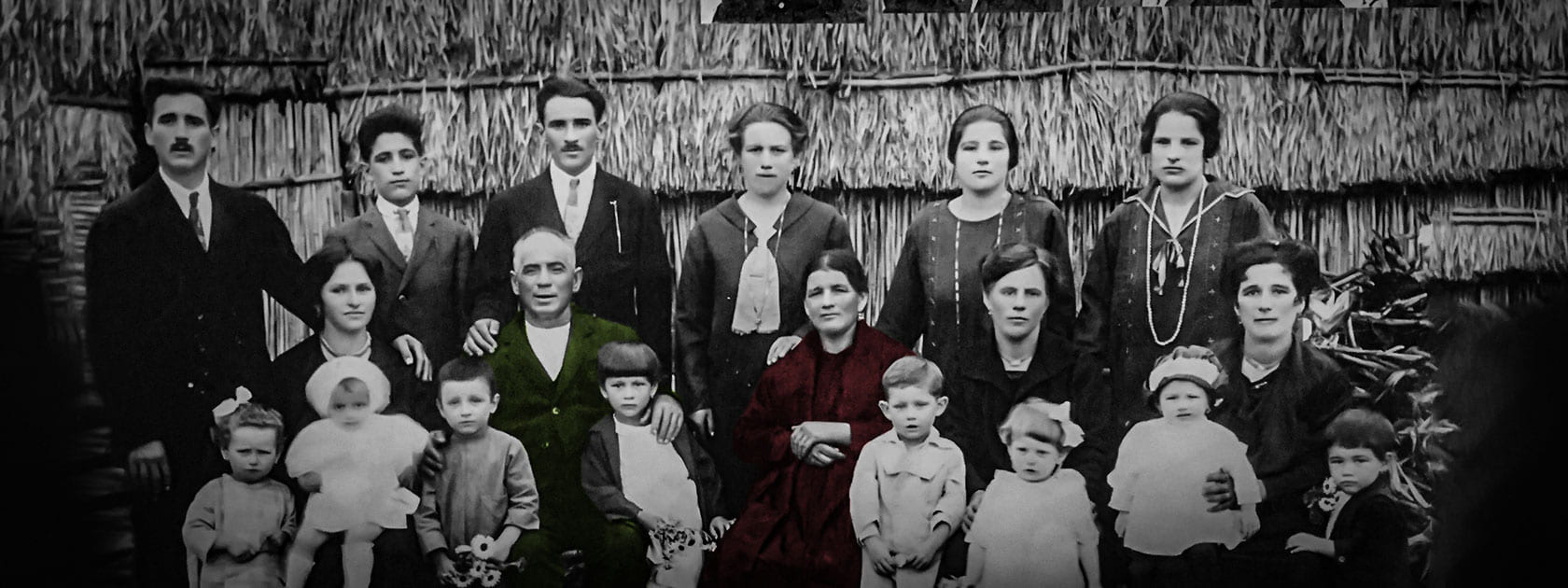
Italian Immigrant Workers in Railroad Construction
Sam Caravaggio’s research focuses on Italian immigrant workers in the railway system in Canada from the early 1900s to the Great Depression by following the research of Bruno Ramirez and by means of the archives located at Pier 21 museum and collected by the Canadian Pacific (CP). The extent of Italian migrant labour and other immigrants employed in the construction of the transportation system in Canada goes underestimated in Canadian history. The large amount of Italian labour and other migrants attracted by the Canadian labour market is an important part of the history of the Canadian Pacific Railway (CPR, incorporated in 1881) and the Grand Trunk Railway (GT, commenced in 1852) in that a demand for a workforce shaped the rise of sojourners and the occurrence of a distinct padronism; temporary workers were pulled into the labour market by a broken patronage system that in most instances left new recruits homeless. The padroni system included Canadian companies and labour agents exploiting migrant workers for cheap labour whereby the immigrant men were never free of the system, working long hours of manual labor and even charged a monthly expense by their agent to retain their employment. Labour agencies were located on the Swiss and Italian border where Italians were recruited and brought to Montreal into this imprisoned relationship; Bruno Ramirez records 4000-8000 Italian men a year employed at CPR’s Angus Works in Montreal from 1904 to about 1930 (13).
Italian migrant workers also entered the Canadian labour market through kingship systems, which provided a more stable employment experience for the migrant worker since a family member in Canada arranged for employment and lodging near the work site upon the migrant’s entrance to a Canadian city. Italians in Canada secured family members to work on industrial projects, such as the CPR lines. One of the best-known chain migrations in Canadian history is the Italian kingship of the Figliomeni Family in Schreiber, Ontario. In 1890, Italian immigrants from the city of Siderno began streaming into Schreiber to find employment with the CPR. Cosimo Figliomeni was responsible for sponsoring many Italian families for the construction and repair of the rail system in Schreiber. The Italian workers are credited with completing the CPR Line in this city and maintaining the railways in the area for many generations. The family prospered in the maintenance shops of Schreiber after the completion of the rail, while other Italian immigrants, such as the Deleo Family—friends of the Figliomeni family, moved with the line as far as Fort Erie, Niagara.
Many Italians migrated to Canada with the hopes of achieving economic and social well-being like the Figliomeni Family. However, Italian immigrants were not viewed as potential landowners to populate Canada nor were they employed for a broad period of time by companies as Sam Caravaggio demonstrates in his research of the CP. As the rail line moved West, companies advertised settling the West and cultivating the land to British settlers as Italians were regarded as temporary manual labour. In some cases, the Italian men moved from one construction project to another, seeking better employment that corresponded to their skills; in most cases, the company rather have young and fresh workers each cycle. Caravaggio places Ramirez’s data in a graph to clearly demonstrate that most Italian immigrants worked one to three months on the rail construction in Montreal. The Canadian Pacific advertisements demonstrates further their targeted audience was British boys and British Farmers as they exploited other immigrants to build the transportation system that would benefit British families. Caravaggio’s research focuses on the employment in Montreal, but the research demonstrates how Italian migrants were viewed by the large Canadian companies that operated in cities across the country and reveals how these companies exploited Italian migrant workers for over thirty years.
Teresa Russo
Toronto, 2019


Avery, Donald. “Dangerous Foreigners”: European Immigrant Workers and Labour Radicalism in Canada, 1896-1931.
Toronto, 1979.
Columbus Centre with Citizenship and Immigration Canada. “Italian stationmen on railway maintenance crew of CPR,” Italian Canadians as Enemy Aliens: Memories of WWII (Accession# LDICEA2011.0019.004).
http://www.italiancanadianww2.ca/collection/details/ldicea2011_0019_0004
Harney, Robert F. “Men Without Women: Italian Migrants in Canada, 1885-1930, in The Italian Immigrant Woman in North America, eds. Betty Boyd Caroli et al, 79-102, Toronto, 1978.
Canadian Pacific. “Immigrant Settlements,” CP Connecting Canada from 1881. CP Archives, 1881-2017.
https://cpconnectingcanada.ca/#immigration-settlements
Ramirez, Bruno. “Brief Encounters: Italian Immigrant Workers on the CPR,” Labour/ Le Travail, vol. 17, Spring 1986, pp. 9-28.
Russo, Teresa. Personal Interview of Mary Deleo. 21 September 2019.


